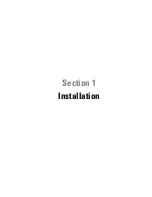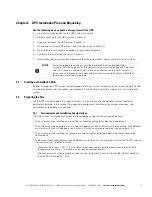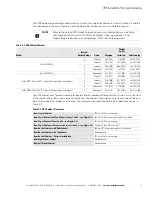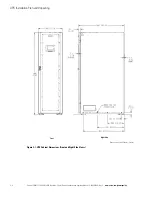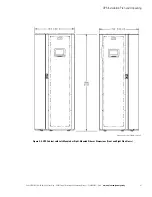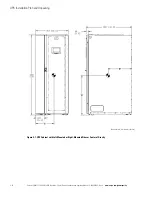
UPS Installation Plan and Unpacking
3-2
Eaton 93PM UPS (20–50 kW, 480V Four Wire – 50 kW Frame) Installation and Operation Manual P-164000540—Rev 4
www.eaton.com/powerquality
l
The newer, more energy efficient data center cooling methods (such as air side economization) can create
much wider ranges of temperature and Relative Humidity (RH) in the UPS room and/or data center. There
are two aspects of this increased operating environment that can, if ignored, create issues.
- One is the creation of microclimates, which are persistent variations of temperature and/or RH within a
single room. For example one side of the room is always cooler than the other side, no matter the actual
temperature.
- The other aspect is the rate of change of temperature and/or RH, which can occur during transitions
within the cooling system. Examples: changing the mixture ratio of inside versus outside air, or external
changes in the outside air when going from night to day, and back to night.
- When ignored, either one of these aspects can create an undesirable microclimate at the UPS location. If
the environment created by this microclimate exceeds the UPS operating specification, the UPS reliability,
over time, will be reduced. These same environmental extremes will also create reliability concerns for
any servers that are exposed to them.
Failure to follow guidelines may void your warranty.
The basic environmental requirements for operation of the UPS are:
l
Ambient Temperature Range: 5–40
C (41–104
F)
l
Recommended Operating Range: 5–40
C (41–104
F)
l
Maximum Relative Humidity: 95%, non-condensing
CAUTION
If battery systems are located in the same room as the UPS, the battery manufacturer's
environmental requirements should be followed if they are more stringent than the UPS
requirements. Operating temperatures above the recommended range will result in decreased
battery life and performance, and may reduce or void the battery warranty.
The UPS ventilation requirements are shown in Table 3-1.
To allow for future power upgrades, Eaton recommends using air conditioning or ventilation sized for the fully
rated UPS kW frame size installed instead of the derated kW ordered. Sizing the site cooling infrastructure to
be capable of cooling the maximum kW frame size will allow a full power rating upgrade without having to
modify the infrastructure.
Table 3-1. Air Conditioning or Ventilation Requirements During Full Load Operation
Model
UPS Rating
Input/Output Voltage
Heat Rejection
BTU/hr x1000 (kg-cal/hr)
Minimum Required
Cooling Air Flow
Eaton 93PM-50-1
Eaton 93PM-50-2 (N+1)
20 kW
480/480
2.55 (643)
189 liter/sec (400 cfm)
Eaton 93PM-50-1
Eaton 93PM-50-2 (N+1)
30 kW
480/480
3.58 (903)
Eaton 93PM-50-1
Eaton 93PM-50-2 (N+1)
40 kW
480/480
4.56 (1150)
Eaton 93PM-50-1
Eaton 93PM-50-2 (N+1)
50 kW
480/480
5.70 (1438)
Summary of Contents for 93PM UPS
Page 1: ...Eaton 93PM UPS 20 50 kW 480V Four Wire 50 kW Frame Installation and Operation Manual...
Page 2: ......
Page 3: ...Eaton 93PM UPS 20 50 kW 480V Four Wire 50 kW Frame Installation and Operation Manual...
Page 25: ...Section 1 Installation...
Page 26: ......
Page 87: ...Section 2 Operation...
Page 88: ......
Page 145: ......
Page 146: ...P 164000540 4 P 164000540 4...












